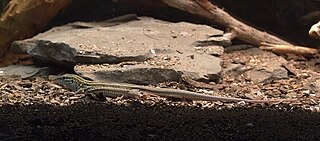
Darevskia is a genus of wall lizards of the family Lacertidae. Member species are native to the Caucasus, Iran and Turkey, living in forest and grassy habitats with numerous rock outcrops. Among rock lizards, seven parthenogenetic species are known.

Lacerta is a genus of lizards of the family Lacertidae.

The desert grassland whiptail lizard is an all-female species of reptiles in North America. It was formerly placed in the genus Cnemidophorus. A common predator of the whiptail lizard is the leopard lizard that preys on A. uniparens by using ambush and stalk hunting tactics. These reptiles reproduce by parthenogenesis. In this process, eggs undergo a chromosome doubling after meiosis, developing into lizards without being fertilized. However, ovulation is enhanced by female-female courtship and mating (pseudo-copulation) rituals that resemble the behavior of closely related species that reproduce sexually.

Darevskia armeniaca, commonly known as the Armenian lizard or the Armenian rock lizard, is a parthenogenetic species of Darevskia, a genus of lizards belonging to the family Lacertidae, the wall lizards. Darevskia armeniaca is native to the Armenian Highland.

Parthenogenesis is a natural form of asexual reproduction in which growth and development of an embryo occur directly from an egg, without need for fertilisation. In animals, parthenogenesis means development of an embryo from an unfertilized egg cell. In plants, parthenogenesis is a component process of apomixis. In algae, parthenogenesis can mean the development of an embryo from either an individual sperm or an individual egg.
Darevskia alpina is a species of lizard in the family Lacertidae. It is found in the Greater Caucasus in Georgia and Russia.
Darevskia chlorogaster, the greenbelly lizard, is a lizard species in the genus Darevskia. It is found in Azerbaijan and Iran.
Parthenogenesis is a mode of asexual reproduction in which offspring are produced by females without the genetic contribution of a male. Among all the sexual vertebrates, the only examples of true parthenogenesis, in which all-female populations reproduce without the involvement of males, are found in squamate reptiles. There are about 50 species of lizard and 1 species of snake that reproduce solely through parthenogenesis. It is unknown how many sexually reproducing species are also capable of parthenogenesis in the absence of males, but recent research has revealed that this ability is widespread among squamates.

Darevskia brauneri, Brauner's rock lizard, is a lizard species in the genus Darevskia. It is found in Georgia and Russia.

Darevskia dahli is a species of lizard in the family Lacertidae. The species is native to Eastern Europe and Western Asia.

Darevskia derjugini is a species of lizard in the family Lacertidae. The species is native to Southeast Europe and Western Asia. There are six recognized subspecies.
Darevskia dryada, the Charnali lizard, is a lizard species in the genus Darevskia. It is found in Georgia and Turkey.
Darevskia parvula, the red-bellied lizard, is a lizard species in the genus Darevskia. It is found in Georgia and Turkey.

Darevskia portschinskii is a species of lizard in the family Lacertidae. The species is endemic to the South Caucasus region of Eurasia. There are two recognized subspecies.

Darevskia praticola, the meadow lizard, is a lizard species in the genus Darevskia. It is found in Georgia, Russia, Iran, Serbia, Bulgaria, Romania, Greece, Azerbaijan, Armenia, and Turkey.

Darevskia raddei, known commonly as the Azerbaijan lizard, is a species of lizard in the family Lacertidae. The species is endemic to Eurasia. There are three subspecies.

Darevskia rostombekowi is a species of lizard in the family Lacertidae. The species is endemic to Transcaucasia.
Darevskia saxicola is a lizard species in the genus Darevskia. It is found in Georgia, Russia, and Turkey.
Darevskia uzzelli is a species of lizard in the family Lacertidae. The species is endemic to Turkey.

Darevskia valentini, also known commonly as the Caucasian rock lizard or Valentin's lizard, is a species of lizard in the family Lacertidae. The species is native to southeastern Europe and western Asia. There are three recognized subspecies.














